Class Reptilia
Order Squamata
Suborder Sauria
Family Phrynosomatidae
Phrynosoma anzaense—Anza Horned Lizard // Phrynosoma blainvillii—Blainville's Horned Lizard // Phrynosoma cornutum—Texas Horned Lizard // Phrynosoma coronatum—Coast Horned Lizard // Phrynosoma hernandesi—Mountain Short-horned Lizard // Phrynosoma modestum—Round-tailed Horned Lizard // Phrynosoma platyrhinos—Desert Horned Lizard // Phrynosoma solare—Regal Horned Lizard
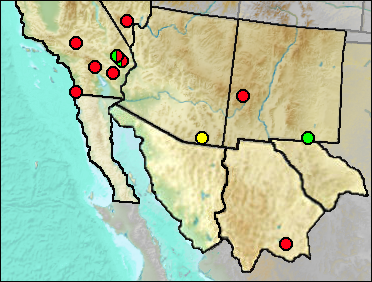
Species of Phrynosoma are useful in that they often are easily identified and tend to inhabit different ecological niches. Phrynosoma hernandesi is adapted for cooler temperatures than the other species of our region. As live-bearers (eggs are retained within body rather than being laid), they can provide sufficient heat for embryonic development by behavioral practices, such as basking in the sun. Egg-layers are at a disadvantage in cool climates, having to depend on sites that are situated to receive sufficient heat.
Sites.
Late Blancan: California Wash (Lindsay 1984).
Medial Irvingtonian: Slaughter Canyon Cave (Morgan and Harris 2015).
Irvingtonian/Rancholabrean: Archer (Jefferson 1991a); Cadiz (Jefferson 2014).
Rancholabrean: Centennial Parkway, Las Vegas Valley (Jefferson et al. 2015); Desert Sunlight Project (Jefferson 2014); Helendale (Jefferson 1991a); Tule Springs (Springer et al. 2005).
Wisconsin: Glen Abbey (Majors 1993).
Mid/Late Wisconsin/Holocene: Jimenez Cave (Messing 1986).
Late Wisconsin: Mountain View Country Club (Jefferson 2014).
Late Wisconsin/Holocene: Bat Cave (Scarbrough 1986).
Literature. Jefferson 1991a, 2014; Jefferson et al. 2015; Lindsay 1984; Majors 1993; Messing 1986; Morgan and Harris 2015; Scarbrough 1986; Springer et al. 2005.
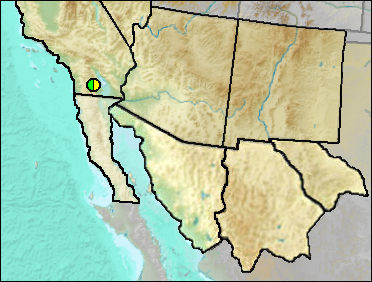
Sites.
Late Blancan/Irvingtonian: Vallecito Creek, Anza-Borrego Desert (Cassiliano 1999).
Literature. Cassiliano 1999.
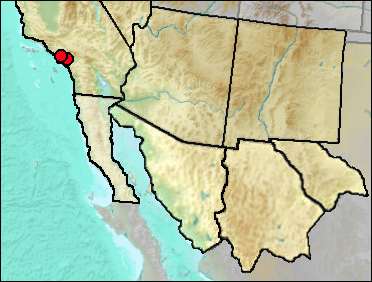
The current geographic range is from the California Bay Area south into Baja California, mostly west of the Sierra Nevada.
Sites.
?Late Irvingtonian/Rancholabrean: Emery Borrow Pit (Jefferson 1991a).
Mid/Late Wisconsin: Rancho La Brea (Brattstrom 1953).
Literature. Brattstrom 1953; Jefferson 1991a.
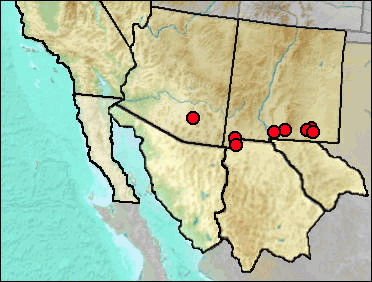
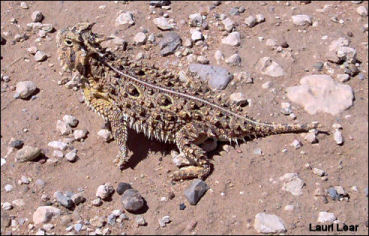 The Texas Horned Lizard is a relatively
warm-climate lizard showing a more-or-less typical grassland distribution from northern Kansas
south into Mexico and hooking westward across southern New Mexico into southeastern Arizona.
The Texas Horned Lizard is a relatively
warm-climate lizard showing a more-or-less typical grassland distribution from northern Kansas
south into Mexico and hooking westward across southern New Mexico into southeastern Arizona.
Applegarth (1979) listed a soft soil, a warm climate, and presence of some dense vegetation (grass, bushes, or weeds) as requirements.
Fig. 1. Texas Horned Lizard (Phrynosoma cornutum). Photograph by Lauri L. Lear.
Sites.
Early/Early-Mid Wisconsin: Lost Valley (Harris 1993c).
Mid Wisconsin: Papago Springs Cave (Czaplewski and Mead et al. 1999); U-Bar Cave (Harris 1987).
Mid Wisconsin-Holocene: Shelter Cave (Brattstrom 1964).
Mid/Late Wisconsin: Dark Canyon Cave (Applegarth 1979)
Mid/Late Wisconsin/Holocene:Sierra Diablo Cave (UTEP).
Late Wisconsin: Bison Chamber (Holman 1970); Pendejo Cave (Harris 2003); Rocky Arroyo midden, 10,560 ± 150 (Van Devender 1980); TT II (Harris 1993c); U-Bar Cave 14-15 ka (Harris 1989: cf.).
Late Wisconsin/Holocene: Burnet Cave (Rickart 1977); Deadman Cave (Mead et al. 1984); Howell's Ridge Cave (Van Devender and Worthington 1977); Pendejo Cave (Harris 2003).
Literature. Applegarth 1979; Brattstrom 1964; Czaplewski and Mead et al. 1999; Harris 1987, 1989, 1993c, 2003; Holman 1970; Mead et al. 1984; Rickart 1977; Van Devender 1980; Van Devender and Worthington 1977.
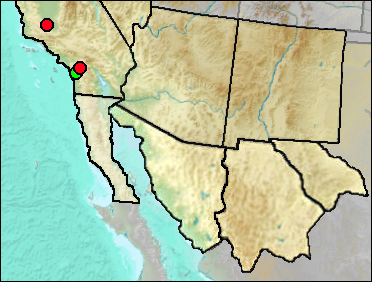
Current distribution of the Coast Horned Lizard is from California's Central Valley south into Baja California.
Sites.
Irvingtonian: Elsinore: Microtus/Mammuthus (Bell 1993).
Mid/Late Wisconsin: Diamond Valley (Springer et al. 2009).
Late Wisconsin: Maricopa (Jefferson 1991a).
Literature. Bell 1993; Jefferson 1991a; Springer et al. 2009.
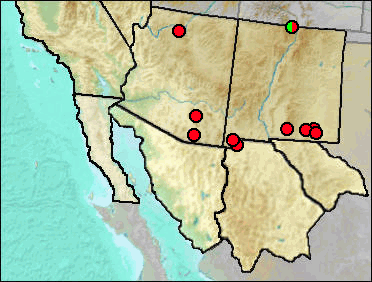
Synonyms. Phrynosoma douglasii. Virtually all of the fossil records of this lizard from our region were recorded under the name Phrynosoma douglasii (often given as Phrynosoma douglassi). Phrynosoma douglasii is now considered to be limited to similar-appearing lizards in the northwestern portion of United States and adjacent Canada, and the former subspecies P. d. hernandesi raised to specific status.
Fig. 1. Mountain Short-horned Lizard (Phrynosoma hernandesi). Photograph by Carl S. Lieb.
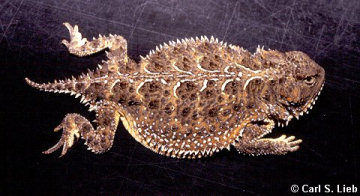 Widespread from southern Canada south through
to the high Sierra Madre Occidental of Mexico, this lizard inhabits grasslands into open forest.
Its viviparous habit apparently allows it to occur in many habitats too cold for most lizards. It
is absent today from the desertscrub lowlands, though it occurs in grassland
and woodland at higher elevations.
Widespread from southern Canada south through
to the high Sierra Madre Occidental of Mexico, this lizard inhabits grasslands into open forest.
Its viviparous habit apparently allows it to occur in many habitats too cold for most lizards. It
is absent today from the desertscrub lowlands, though it occurs in grassland
and woodland at higher elevations.
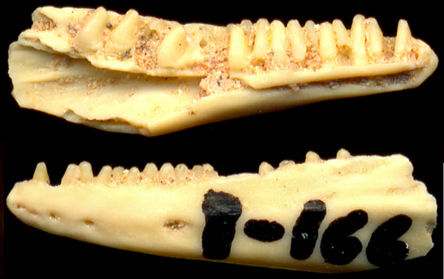
This is one of the most widespread lizards from the Wisconsin of our region. Applegarth (1979) hypothesized that only this species of lizard was able to thrive at Dry Cave during the pleniglacial; that the other three species of lizards noted as present at that time occurred only in small numbers due to marginal soil temperatures for egg development.
Fig. 2. Left dentary of Phrynosoma hernandesi from the Lost Valley site, Dry Cave, Eddy Co., NM. UTEP 1-166.
Sites.
Medial Irvingtonian: SAM Cave (Rogers et al. 2000)
Early/Early-Mid Wisconsin: Lost Valley (Harris 1993c); Rm Vanishing Floor (Harris 1993c).
Mid Wisconsin: CC:5:2 (Mead et al. 2003); Pendejo Cave (Harris 2003); U-Bar Cave (Harris 1987)
Mid/Late Wisconsin: Dark Canyon Cave (Rickart 1977); NW Talus Slope (Harris 1993c); Sierra Diablo Cave (UTEP).
Late Wisconsin: Algerita Blossom Cave (Harris 1993c); Animal Fair 18-20 ka (Applegarth 1979; Harris 1989); Bison Chamber (Holman 1970); CC:5:4 (Mead et al. 2003); Charlies Parlor (Harris 1989); Dust Cave (this work: cf.); Harris' Pocket (Holman 1970); Sheep Camp Shelter (Harris 1993c); TT II (Harris 1993c); U-Bar Cave 13-14 ka (Harris 1989); U-Bar Cave 14-15 ka (Harris 1989: cf.); U-Bar Cave 15-18 ka (Harris 1989); U-Bar Cave 18-20 ka (Harris 1989).
Late Wisconsin/Holocene: Balcony Room (Harris 1993c); Beyond Bison Chamber (Holman 1970); Burnet Cave (Rickart 1977); Deadman Cave (Mead et al. 1984); Howell's Ridge Cave (Van Devender and Worthington 1977); Pendejo Cave (Harris 2003); SAM Cave (Rogers et al. 2000).
Literature. Applegarth 1979; Harris 1987, 1989, 1993c, 2003; Holman 1970; Mead et al. 1984; Mead et al. 2003; Rickart 1977; Rogers et al. 2000; Van Devender and Worthington 1977.
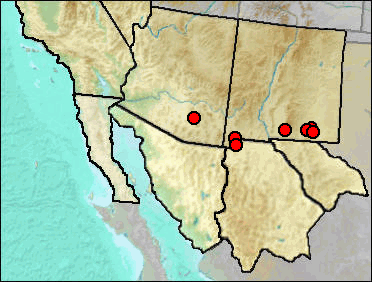
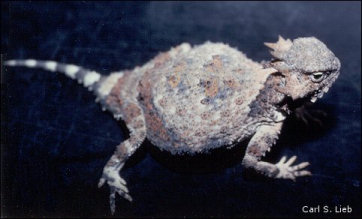 This is a predominantly desert species of sparse
vegetation and, usually, a gravelly terrain (Applegarth 1979). Applegarth pointed out that the
three horned lizard species in southern New Mexico represent a gradient of preferred habitats, from cool mesic grasslands
(P. hernandesi) to warm grasslands (P. cornutum) to open desert terrain and a warm
climate (P. modestum).
This is a predominantly desert species of sparse
vegetation and, usually, a gravelly terrain (Applegarth 1979). Applegarth pointed out that the
three horned lizard species in southern New Mexico represent a gradient of preferred habitats, from cool mesic grasslands
(P. hernandesi) to warm grasslands (P. cornutum) to open desert terrain and a warm
climate (P. modestum).
Fig. 1. Round-tailed Horned Lizard (Phrynosoma modestum). Photograph by Carl S. Lieb.
Sites.
Early/Early-Mid Wisconsin: Lost Valley (Harris 1993c).
Mid Wisconsin: Pendejo Cave (Harris 2003); U-Bar Cave (Harris 1993c).
Mid/Late Wisconsin: Dark Canyon Cave (Applegarth 1979).
Mid/Late Wisconsin/Holocene: Sierra Diablo Cave (UTEP).
Late Wisconsin: Rocky Arroyo midden, 10,560 ± 150 (Van Devender 1980); TT II (Harris 1993c).
Late Wisconsin/Holocene: Deadman Cave (Mead et al. 1984); Howell's Ridge Cave (Van Devender and Worthington 1977); Pendejo Cave (Harris 2003).
Literature. Applegarth 1979; Harris 1993c, 2003; Mead et al. 1984; Van Devender 1980; Van Devender and Worthington 1977.
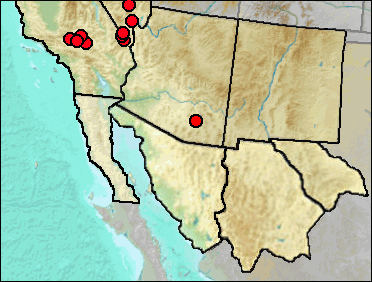
Currently, Phrynosoma platyrhinos inhabits western Arizona and to the west and north.
Sites.
Rancholabrean: Centennial Parkway, Las Vegas Valley (Jefferson et al. 2015: cf. gen. et sp.); Clay Mine Road (Jefferson 2014); Cool Water Coal Gasification Solid Waste Site (Jefferson 1991a); Hoffman Road (Jefferson 2014: ?); Piute Ponds (Jefferson 2014: cf.).
Mid Wisconsin: Devil Peak (Jefferson et al. 2015; Reynolds, Reynolds, and Bell 1991).
Mid/Late Wisconsin: Pintwater Cave (Hockett 2000).
Late Wisconsin: Antelope Cave (Reynolds, Reynolds, Bell, and Pitzer 1991); Gypsum Cave (Brattstrom 1954); Picacho Peak (Van Devender et al. 1991).
Late Wisconsin/Holocene: Kokoweef Cave (Reynolds, Reynolds, et al. 1991); Luz Solar Trough (Jefferson 1991a); Solar One (Jefferson 1991a).
Literature. Brattstrom 1954; Hockett 2000; Jefferson 1991a, 2014; Jefferson et al. 2015; Reynolds, Reynolds, and Bell 1991; Reynolds, Reynolds, et al. 1991; Reynolds, Reynolds, Bell, and Pitzer 1991; Van Devender et al. 1991.
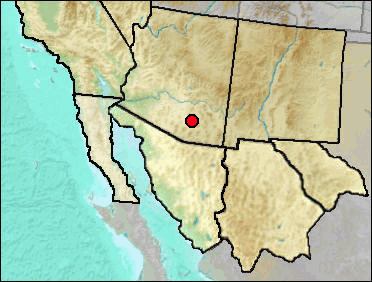
Present distribution is southeastern Arizona with an extension northwest to southern Mohave County and, on the southeast, barely overlapping into New Mexico.
Sites.
Wisconsin/Holocene: Deadman Cave (Mead et al. 1984).
Literature. Mead et al. 1984.
Last Update: 3 Feb 2016